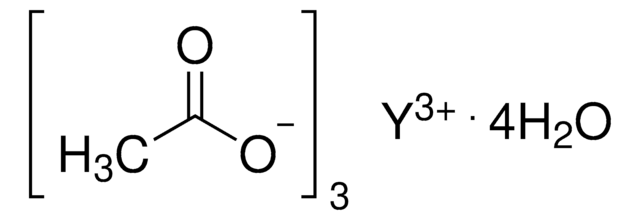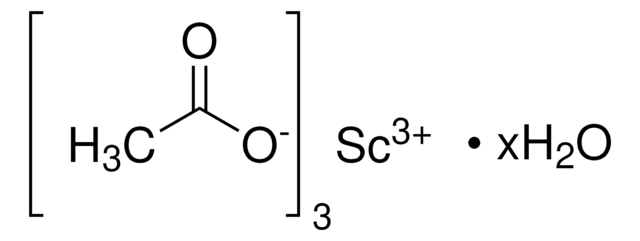326046
Yttrium(III) acetate hydrate
99.9% metals basis
Synonym(s):
Yttrium triacetate
About This Item
Recommended Products
Assay
99.9% metals basis
form
powder
reaction suitability
core: yttrium
reagent type: catalyst
SMILES string
O.CC(=O)O[Y](OC(C)=O)OC(C)=O
InChI
1S/3C2H4O2.H2O.Y/c3*1-2(3)4;;/h3*1H3,(H,3,4);1H2;/q;;;;+3/p-3
InChI key
JRKVGRAQLBXGQB-UHFFFAOYSA-K
Application
- Optical study of Yttrium oxide doped with zinc prepared by simple methods: The research investigates the optical properties of yttrium oxide doped with zinc, using yttrium acetate hydrate in the synthesis process. (Bhavani, Ganesan, 2015).
- Thermal decomposition of yttrium propionate: film and powder: This paper details the thermal decomposition behavior of yttrium propionate, a compound related to yttrium acetate, providing insights into decomposition mechanisms and thermal stability. (Rasi et al., 2018).
- In Situ Ternary Adduct Formation of Yttrium Polyaminocarboxylates Leads to Small Molecule Capture and Activation: This research investigates the formation of ternary adducts with yttrium complexes, using acetate and other ligands, demonstrating potential applications in small molecule activation. (Tickner et al., 2022).
Storage Class Code
11 - Combustible Solids
WGK
WGK 3
Flash Point(F)
Not applicable
Flash Point(C)
Not applicable
Personal Protective Equipment
Certificates of Analysis (COA)
Search for Certificates of Analysis (COA) by entering the products Lot/Batch Number. Lot and Batch Numbers can be found on a product’s label following the words ‘Lot’ or ‘Batch’.
Already Own This Product?
Find documentation for the products that you have recently purchased in the Document Library.
Customers Also Viewed
Articles
Three approaches generate white light, including LED-based down-conversion for broader applications.
Three approaches generate white light, including LED-based down-conversion for broader applications.
Three approaches generate white light, including LED-based down-conversion for broader applications.
Three approaches generate white light, including LED-based down-conversion for broader applications.
Our team of scientists has experience in all areas of research including Life Science, Material Science, Chemical Synthesis, Chromatography, Analytical and many others.
Contact Technical Service









